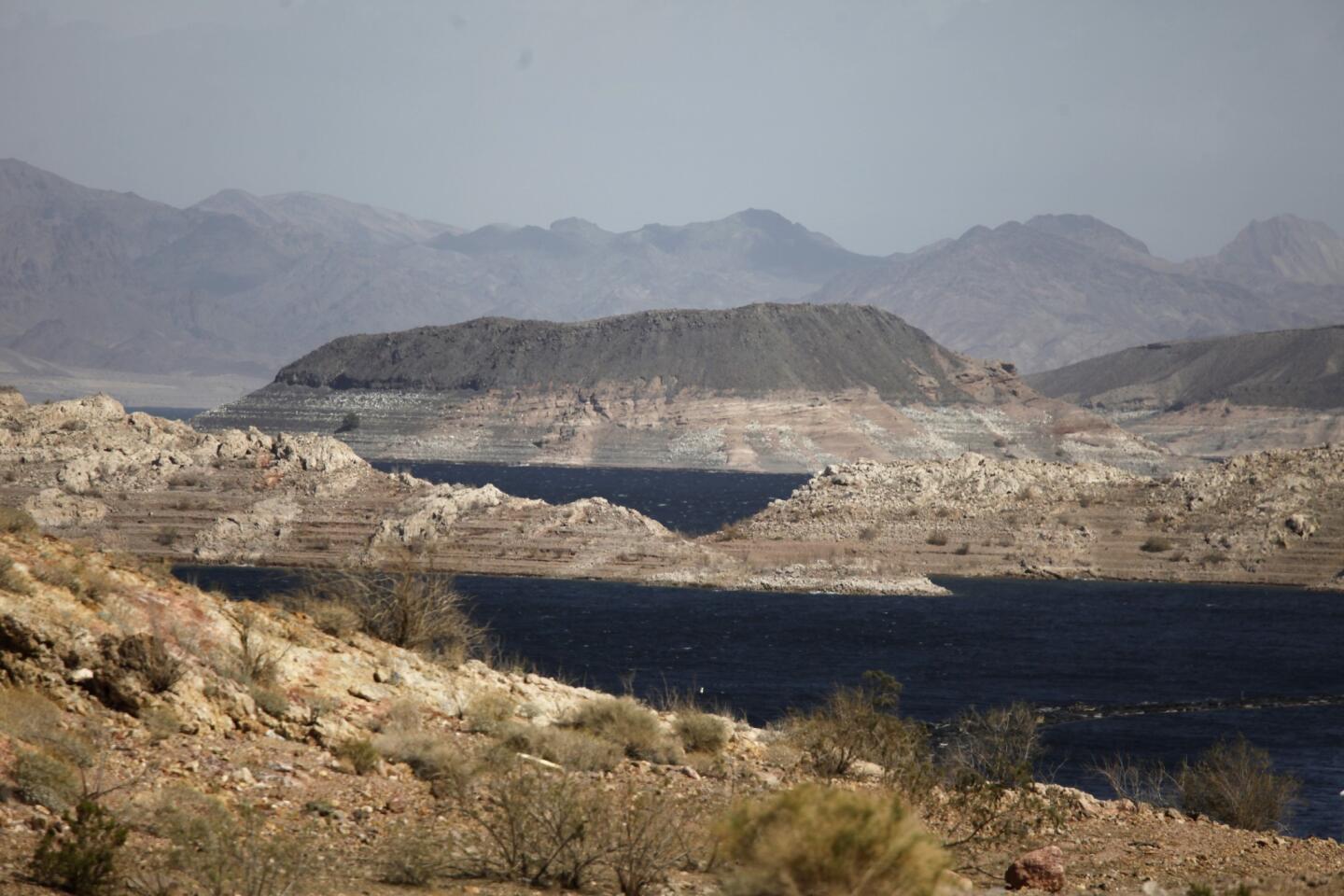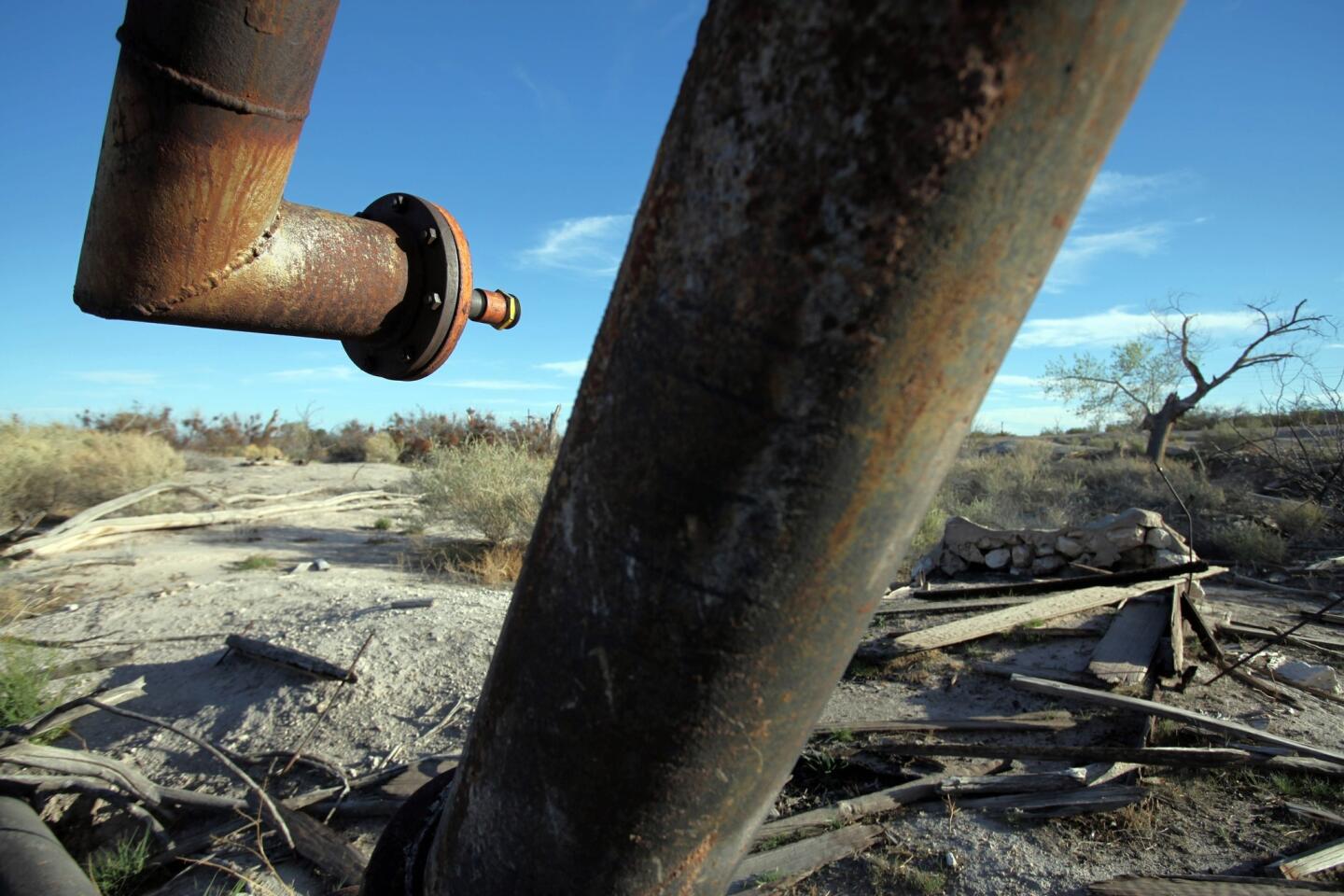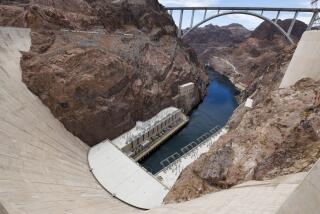Drought -- and neighbors -- press Las Vegas to conserve water
LAS VEGAS — Deep beneath Lake Mead, a 23-foot-tall tunnel-boring machine grinds through stubborn bedrock in a billion-dollar effort to make sure water continues flowing to this thirsty resort city.
For six years, the Southern Nevada Water Authority has been building an intake straw below the reservoir’s two existing pipes. Due for completion in fall 2015, critics say it may not provide a long-term solution.
An ongoing drought and the Colorado River’s stunted flow have shrunk Lake Mead to its lowest level in generations. The reservoir, which supplies 90% of Las Vegas’ water, is ebbing as though a plug had been pulled from a bathtub drain. By mid-April, Lake Mead’s water level measured just 48 feet above the system’s topmost intake straw.
Future droughts and a warming climate change could spell trouble for the city’s 2 million residents — and its 40 million annual visitors. Those people “better hope nothing goes wrong with the last intake,” said water authority spokesman J.C. Davis.
“But if something does go wrong,” he added, “we’re in the business of making contingency plans.”
For officials here, the scenario signifies a formidable job: providing water for the nation’s driest city. Las Vegas uses more water per capita than most communities in America — 219 gallons of water per person every day — and charges less for it than many communities.
Summer temperatures top 115 degrees in a scorched environment that in a banner year receives a paltry four inches of rain. The inhospitable conditions have pushed officials to develop water conservation programs considered models worldwide.
Although this spring’s snowmelt could temporarily replenish Lake Mead, the city’s future still looks drier than ever, a prospect that has prompted the water authority to eye such long-term plans as a desalinization plant in California and a $15-billion pipeline to move water here from other parts of the state.
Environmentalists blast the proposed pipeline from central Nevada as irresponsible, calling it a resource grab comparable to William Mulholland’s move that created an aqueduct to transport water south from California’s Owens Valley to help expand Los Angeles a century ago.
They say the city has been cavalier about looming water shortages, pointing to projects such as Lake Las Vegas, a 320-acre artificial oasis built with man-made rivers and waterfalls amid the high-end homes and luxury resorts.
But water use — and how to curtail it — poses a complex puzzle, officials say. Take the casinos.
John Entsminger, the water authority’s new general manager, says such seemingly careless spectacles as the elaborate fountains at the Bellagio resort feature recycled water. “The Strip uses only 3% of the region’s water but supplies 70% of its economy,” he said. “That’s not a bad bargain.”
Officials say they have prepared for myriad possible scenarios, including an emergency slashing of Las Vegas’ annual water allotment. “It’s important to remember that this would happen over a period of years, not months and not weeks,” Davis said of such a cutback. “You don’t wake up one morning and ask, ‘Where did all the water go?’”
Still, water officials here acknowledge that their challenge is to keep Las Vegas livable while reining in several older neighborhoods that have resisted taking out lawns and other conservation measures. The authority has already achieved a remarkable feat: In recent years, Las Vegas and its suburbs have cut water use by one-third while adding 400,000 residents.
It was done in part with a $200-million fund to provide rebates for replacing grass with desert landscapes. Las Vegas also recycles all water that goes down the drain from dishwashers, sinks, showers and even toilets, and after reprocessing, it is pumped back into Lake Mead. With each gallon returned to the reservoir, the city gets to take another out.
The water authority plans to cut per-capita water use even further to 199 gallons a day by 2035, a rate still higher than California’s present average of 182 gallons.
The Colorado River provides water for 40 million people across the Southwest — the majority of them in cities such as Las Vegas. The region’s population is expected to almost double by 2060. In that time, Las Vegas will gain 1 million residents, forecasters say.
Many water experts say Las Vegas needs to immediately take a series of no-nonsense steps to help control its water shortage: Cut indoor as well as outdoor use; charge much more for water and punish abusers with precipitously higher rates; and start disclosing the rate of a neighbor’s water use in residential bills to create more social pressure to conserve.
“At some point, you have to live within your means, but that doesn’t fit with the image of Las Vegas,” said Steve Erickson, Utah coordinator for the Great Basin Water Network, an advocacy group. “These people need to remember that it’s a city built upon an inhospitable desert. What were they thinking?”
When it comes to water, this city has long been at a disadvantage: A 1922 Colorado River water-sharing agreement among seven Western states — one still in effect nearly a century later — gives Southern Nevada the smallest allotment of all: just 300,000 acre-feet a year. An acre-foot can supply two average homes for one year.
Worse, unlike such cities as Phoenix and Los Angeles, Las Vegas has just one major water source — Lake Mead — putting it most at risk during a prolonged drought and dwindling lake water reserves. The city receives a scant 10% of its water from underground local aquifers.
Officials say Las Vegas uses only 80% of its Colorado River allotment and is banking the rest for the future. But critics say that even if the city taps all of its entitled water, that amount would still not be enough to meet its needs in a prolonged drought. And after years of recession, building is starting to come back here, leaving many to ask: Where are all these new residents going to get their water?
“How foolish can you be? It’s the same fatal error being repeated all over the Southwest — there is no new water,” said Tim Barnett, a marine physicist at UC San Diego’s Scripps Institution of Oceanography and coauthor of two reports about dwindling Western water resources. His research concluded that without massive cutbacks in water use, Lake Mead had a 50% chance of deteriorating to “dead pool” by 2036. That’s the level at which the reservoir’s surface drops beneath Las Vegas’ lowest water intake.
Yet casinos and developers continue to push growth, and critics say lawmakers often seem to lack the willpower to draw the line. “Will Las Vegas remain a boom town in the 21st century? The city wants to appear confident but it’s a place built on illusion and luck,” said Emily Green, an environmental journalist who writes about water issues on her blog, Chance of Rain.
“When it comes to water,” she added, “those aren’t very good guiding principles.”
The real water hog is not people, many say, but grass: About 70% of Las Vegas water goes to lawns, public parks and golf courses. A rebate program has already ripped out 168 million square feet of grass, enough to lay an 18-inch-wide roll of sod about 85% of the way around the Earth.
But is Las Vegas ready to ban grass entirely? “Well, at that point you’re seriously impacting quality of life. We’re not being complacent. We’re just not ready for draconian cuts,” said Davis, the spokesman for the water authority.
Barnett argues that’s precisely the wake-up call people need. “All these people assume this water thing will just work itself out. Well, suppose we’re looking at a change in our basic climate, where scarce water is only going to get more scarce. That’s the alternative you need to plan for — and no one’s doing it.”
Many ask why Las Vegas continues to allow projects such as Lake Las Vegas. The lake is filled with 3 billion gallons of Colorado River water, enough to supply 18,000 residences for a year. And 1.4 billion gallons must be added annually to stop the lake from receding.
Davis said the project was conceived well before the current water crisis. “Would we build another man-made lake today? Clearly not. But stop supplying water there and values will plummet. How many lawsuits do you want to wade through regarding people’s quality of life?”
The water authority is pushing forward with a plan for a 300-mile pipeline to import water from the state’s agricultural heartland. The project has touched off such old Nevada grudges as north versus south and claims about urbanites enriching themselves as the expense of rural dwellers.
Environmentalists are challenging in court the right-of-way permits already secured by the water authority, and are promising a long legal battle.
Entsminger, the head of the water authority, believes the American Southwest must fight its water crisis together. He said the seven states drawing water from the Colorado River collectively form the world’s fifth-largest economy — just behind Germany but ahead of France and Britain.
Southern Nevada, he insists, will do its part. And a big part of that, he said, will mean turning off the lawn sprinklers. He acknowledged he’s a culprit.
His front yard features a small patch of ornamental grass planted by the previous homeowners. “I know I should take it out,” the water czar said with a grimace. “It’s on my list.”
More to Read
Sign up for Essential California
The most important California stories and recommendations in your inbox every morning.
You may occasionally receive promotional content from the Los Angeles Times.















